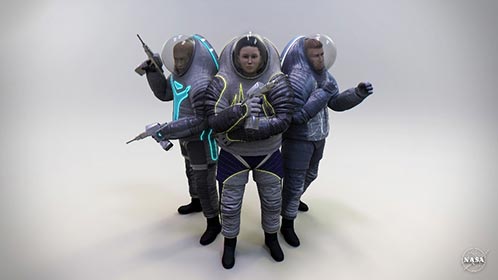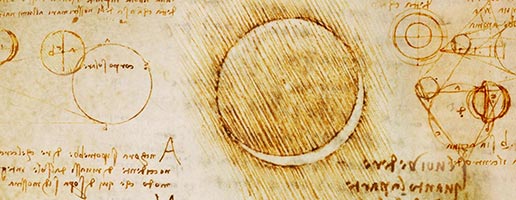Exploration Suits
Wanna visit Mars? What would you wear? NASA’s suit engineers are on the job to develop materials and designs that withstand extremes of climate and gravity—a feat that Leonardo da Vinci envisioned five centuries ago.

Photo credit: NASA
The pioneers at NASA developed the first suits that made Extra Vehicular Activities (EVA's) possible. The first astronaut to walk in space, Ed White, was celebrated as the "Ambassador of Exploration" when he ventured into uncharted territory on June 3, 1965. Through his feat, humanity first gained access to the once perilous void of outer space.
Obviously, he needed protection. Space suits performed as self-enclosed worlds and became the vessel for exploration.
Since that maiden spacewalk, humans have stepped on the moon, repaired satellites, and even made a home outside Earth's atmosphere. Astronauts protected by their space suits have repaired the Hubble telescope and maintained the International Space Station.

Besides the new streamlined fashionable look, these prototype suits exhibit better mobility, visibility, and control. The PXS focuses on microgravity maneuverability while the Z2 focuses on exploration on a planetary surface. NASA is working avidly to make the suits an integrative tool as opposed to a mobile hindrance while still maintaining the protective elements necessary for space voyages.

Humanity's thirst for exploration means constantly-evolving technologies to enable us to survive in inhuman environments, and opening doors to new and strange arenas for discovery, like outer space. An earthbound Leonardo Da Vinci explored many learning arenas through art, nature, engineering, but many are not aware of his interest in the world outside our world, more specifically the moon.

This illustration is of a crescent shaped moon and the faint image of the full moon that can be observed at sunset. Leonardo referred to it as Earthshine, because he believed the earth's oceans reflected the sunlight onto the moon. The great Da Vinci made this claim without even a telescope to magnify the moon, yet he was only wrong in that it is not the oceans but instead the clouds that reflect this light and create this ghostly glow.
Leonardo arenas of learning had no limit from outer space even to the depths of the oceans. Although he never made it that low, he had design of a suit that would have opened that door to mankind just as the space suits today. The diving apparatus consisted of breathing hoses connected to a floating bell full of air. He even considered water pressure by reinforcing the component with steel rings. Leonardo was working to open the door to the underwater frontier just as the engineers at NASA are developing the suits for the major frontier of outer space.
Want to Learn More?
- "Leonardo to Mars" , 30 Nov, -0001. http://leonardo-to-mars.com/. Accessed on 20 May, 2016.
- Jakab, Peter. "An Extraordinary Journey: The History of Leonardo da Vinci's Codex on the Flight of Birds" Smithsonian National Air and Space Museum, 13 Sep, 2013. https://airandspace.si.edu/stories/editorial/extraordinary-journey-history-leonardo-da-vinci%E2%80%99s-codex-flight-birds. Accessed on 20 May, 2016.